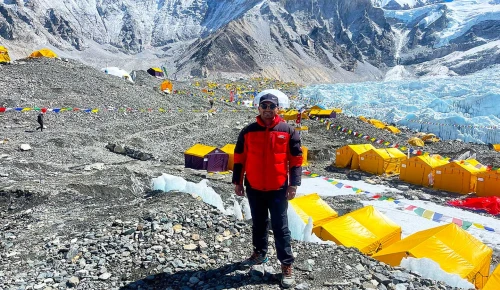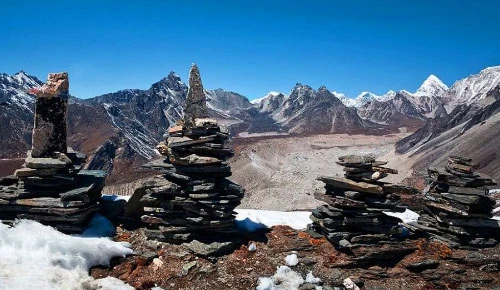Sagarmatha National Park
Protected Area Information
Name: Sagarmatha National Park
Type: National Park
Established: 1976 Area (km2): 1148.00
Buffer Zone (km2): 275.00

Description
Sagarmatha (Mt. Everest) National Park is a national park located in the Khumbu region of Nepal. Established in 1976, it covers an area of 1,148 sq. km in the Himalayan ecological zone. The park is known for its rugged terrain and gorges, and it includes the upper catchment areas of the Dudhkoshi and Bhotehoshi Rivers. The highest point in the park is Sagarmatha (Mt. Everest) at 8,848m above sea level, making it the world's highest peak. Other notable peaks in the park include Lhotse, Cho Oyu, Thamserku, Nuptse, Amadablam, and Pumori. The region is also home to the Sherpa people, who follow the teachings of Buddhism. Monasteries like Tengboche, Thame, Khumjung, and Pangboche are important cultural and religious sites in the area. Sagarmatha National Park was recognized as a World Heritage Site by UNESCO in 1979 for its exceptional natural characteristics.
Flora and Fauna
The vegetation in Sagarmatha National Park varies depending on the altitude. At lower altitudes, you can find pine and hemlock forests, while higher altitudes are characterized by fir, juniper, birch, rhododendron, and alpine plant communities. The park is also home to a diverse range of wildlife, including the red panda, snow leopard, musk deer, Himalayan tahr, marten, Himalayan mouse hare (pika), and over 118 species of birds such as the Impeyan pheasant, snow cock, blood pheasant, and red-billed cough.
How to Get There
There are several ways to reach Sagarmatha National Park from Kathmandu:
- Flight to Lukla and two days' walk
- Bus to Jiri and ten days' walk
- Flight to Tumlingtar and ten days' walk
- Flight to Phaplu and five days' walk
It is important to note that trekking in the park requires a guide and proper equipment.
Buffer Zone
In 2002, the Government of Nepal declared a buffer zone in and around Sagarmatha National Park. The objective of this buffer zone is to reduce biotic pressure on the slow-growing vegetation in the area. The government has also implemented a provision to allocate 30-50 percent of the park's revenue for community development activities in the buffer zone. The collaboration with local communities aims to conserve biodiversity in the region.
Popular Trekking Routes
Sagarmatha National Park offers various trekking routes that provide breathtaking views and cultural experiences. Some of the popular trekking routes include:
- Everest base camp Trek
- Namche to Kala Patthar
- Gokyo Lake and Chukung valleys
- Thame Valley for Sherpa culture
- Phortse for wildlife viewing
It is important for trekkers to have a guide and proper equipment for these treks.
Table of Contents
Sagarmatha National Park is a protected area located in the Solu-Khumbu district of Nepal. It is an exceptional area with dramatic mountains, glaciers, deep valleys, and seven peaks over 7,000 meters, including Mount Everest, the highest peak in the world at 8,848 meters.
Establishment and Recognition
Sagarmatha National Park was established on July 19, 1976, and in 1979, it became the first national park in Nepal to be inscribed as a Natural World Heritage Site by UNESCO. It covers an area of 124,400 hectares.
Biodiversity
The park is home to several rare species, including the snow leopard and the red panda. It also hosts 208 bird species, such as the Impeyan pheasant, bearded vulture, snowcock, and alpine chough, making it an Important Bird Area.
Vegetation
The vegetation in Sagarmatha National Park varies with altitude. At lower altitudes, you can find pine and hemlock forests, while fir, juniper, birch, rhododendron, scrub, and alpine plant communities are present at higher altitudes.
Cultural Significance
The presence of the Sherpas, with their unique culture, adds extra value to the park. The Dudh Kosi valley, within the park, is home to the Sherpa culture and is an ecological unit of significance.
Activities and Tourism
Sagarmatha National Park is a popular destination for mountain tourism. It offers several trails and treks, including the iconic Everest Base Camp trek. However, hiking in the park can be challenging due to high altitudes, rugged terrain, steep inclines, and limited oxygen, so it is recommended for those in better physical condition.
Conclusion
Sagarmatha National Park is a remarkable natural and cultural heritage site in Nepal. With its stunning mountains, glaciers, and diverse wildlife, it attracts visitors from around the world. Whether you're an adventure seeker or interested in experiencing the unique Sherpa culture, Sagarmatha National Park offers a truly unforgettable experience.








